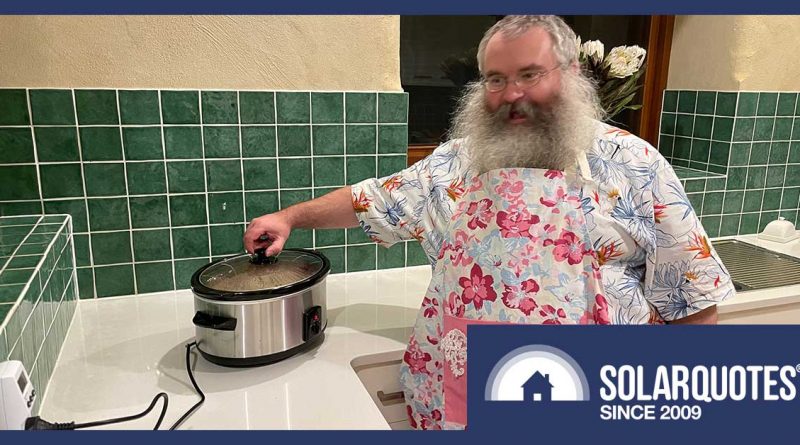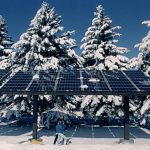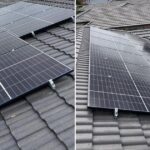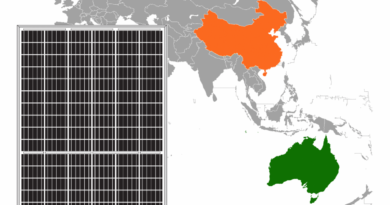Slow Cookers & Solar — A Perfect Combination (Free Bonus Recipe!)
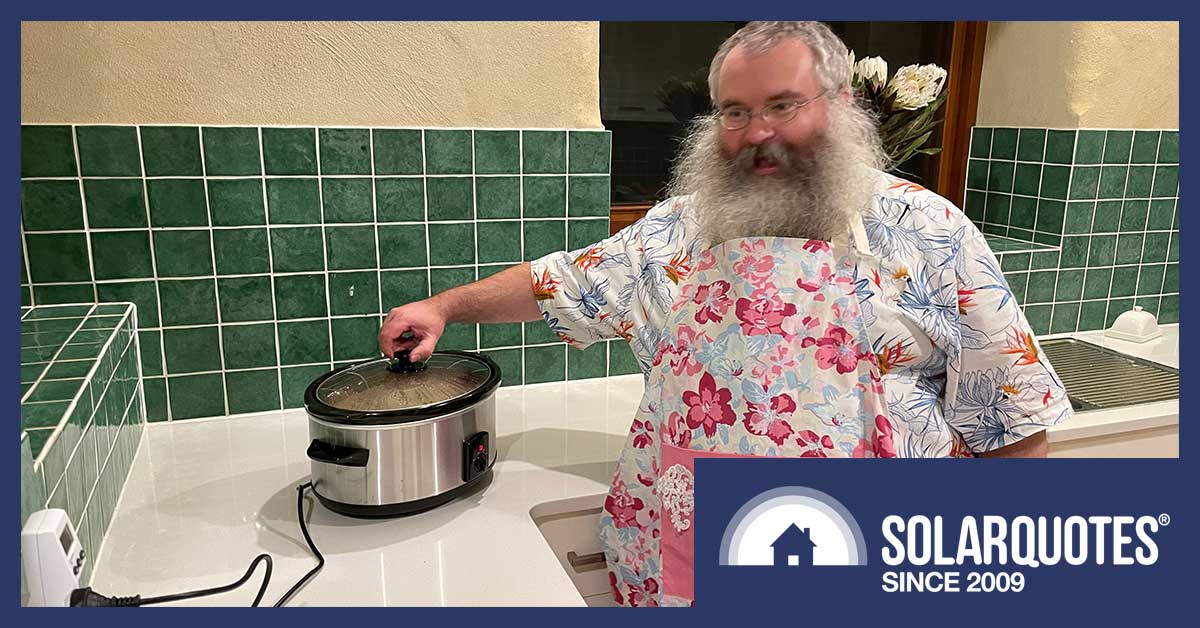
Winter is coming. The cold month of June is almost upon us. In Adelaide where I dwell, winter brings grey skies and decreased solar output. The cold, dark of the evening arrives early and brings a time for family, fellowship, and food.
Now is the perfect time for me to write about slow cookers and how useful they are for solar households. They consume a similar amount of energy to using an electric stove in the evening, but switching on a slow cooker in the morning has several advantages:
- It can run entirely, or almost entirely, from solar power. This improves solar energy self-consumption.
- Reducing the amount of power used during the evening peak helps lower electricity costs for everyone.
- It’s a convenient and easy way to cook.
- It can be healthy — but that will depend on what you put in the slow cooker.
To show slow cookers are a good fit for households with solar panels, I decided to create a slow cooker solar challenge. This involved…
- Buying a slow cooker.
- Cooking a meal using solar power.
- Measuring the energy consumption, and…
- Feeding the food to Finn and his family to decide if my culinary efforts were a success.
After setting myself this task, I decided to devote every ounce of energy I had to achieving success. I’d either prove to Finn’s family that I can make great food using a solar-powered slow cooker or die trying. Of course, there was always the possibility that if my cooking was awful enough they might die from my trying. But I got around that problem by not mentioning it to them.
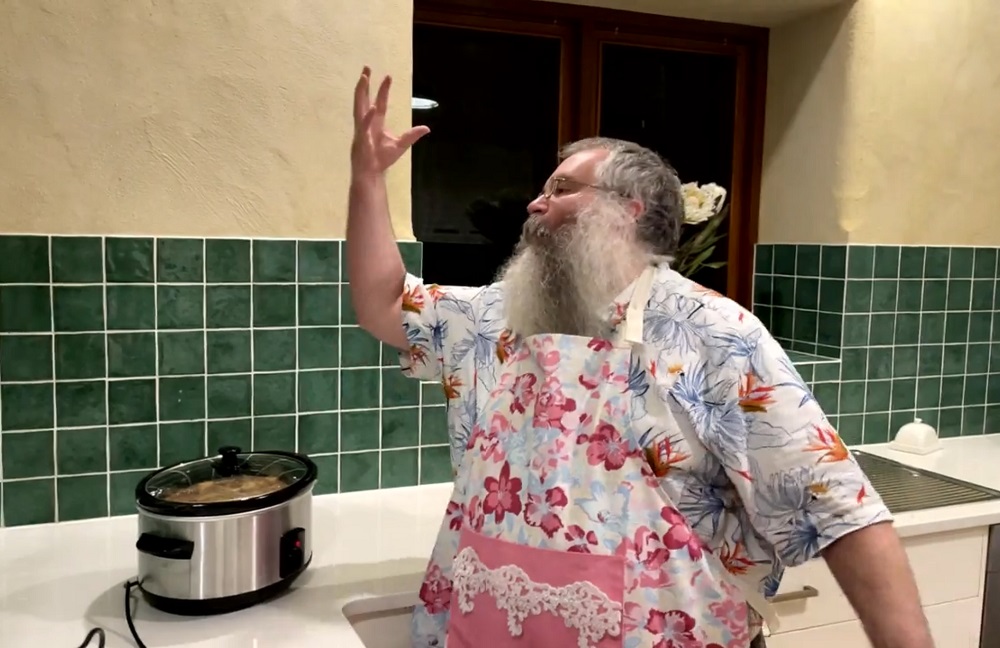
Here you see me beseeching Dionysus, the Greek god of food and wine, to stop turning my hand into a claw for a minute so I can finish cooking.
A $19 Slow Cooker
I wanted confidence that buying a slow cooker is a good investment, so I got a really cheap one. Kmart had one for $19 with a 5.5 litre capacity. I thought it looked more than large enough in the store, but after using it, I think it’s just big enough for a family of five. To be clear, that’s for feeding a family of five, not cooking them.
International cookbooks say a 5.5 litre slow cooker is large enough to serve 10 or 11 people — so that’s about 5 Australians. But note I’m planning to make a “one pot meal”1 that doesn’t require any additional dishes. Of course, you can have extras if you want.
I didn’t get any bells and whistles for that price. It has one dial with three settings — low, high, and warm — and that’s it. There’s no timer, clock, wi-fi, inlaid diamonds, or anything like that.
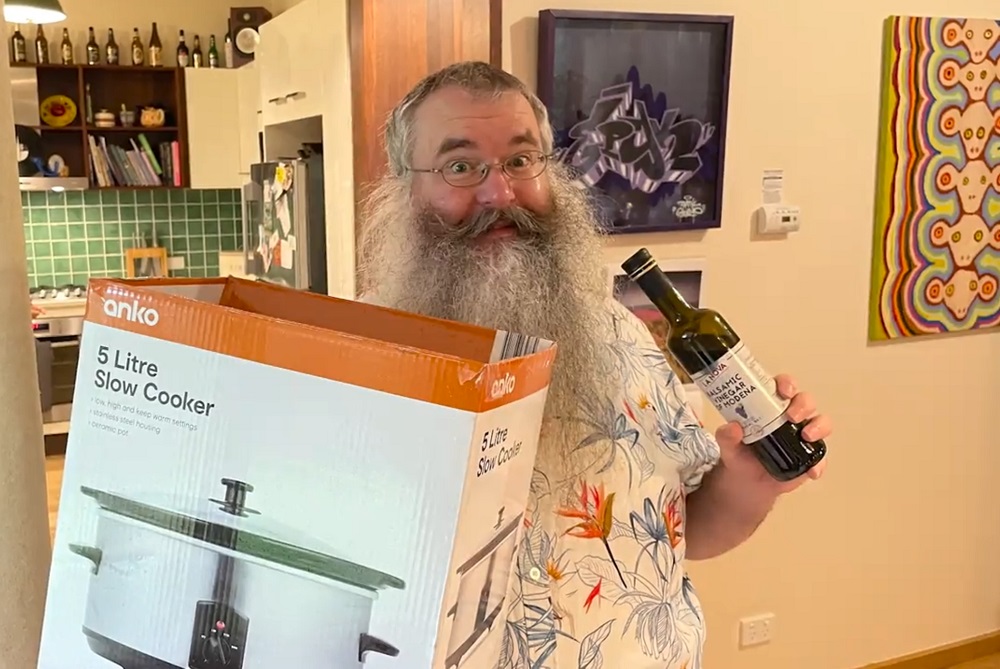
An Energy Inefficient Design
The slow cooker has a stainless steel exterior with a heating element in the base. A deep ceramic dish sits inside and holds the food. After the cooking’s done, you can take the dish out and put it on the table.
From the point of view of energy efficiency, it’s inside out. It would be better to have a steel pot to hold the food and a ceramic exterior to trap the heat inside. It would be even better if the manufacturer replaced the resistance heating element in the base with an induction element that heated the steel pot directly. That way, less energy would be wasted heating the base and the rest of the kitchen.
A timer that would automatically change from “cook” to “warm” would also save energy. Then it could be set to cook for as long as required — perhaps four hours for most dishes — and then switch to the low power “warm” setting. Unfortunately, looking online, cookers with a timer seem to cost at least $130 more. On the bright side, these tend to be “multi-cookers” and can also be used as rice and pressure cookers.
But I can’t complain too much about my cooker’s low-cost design given its price. At only $19, that’s less than what I earn in a week. (I only earn a few dollars a day. Anything I happen to get above that is due to capital and network effects I’m not responsible for.)
Induction Stoves Can Slow Cook
You don’t need to buy a slow cooker if you have a good induction stove. Most have a slow cooker setting so you can just use a large pot. If you don’t have an induction slow cooker, you should consider getting one when your stove needs replacing. They cook faster than gas — we know because we tested it — and use less energy than a conventional electric stove.
The drawback is you’ll need to replace your pots with ones that work with induction cookers. I suggest getting a small portable induction hot plate you can plug in and one or two induction-suitable pots. Then when you get a full-size induction stove, the change over will be easy.
Cooking In The Straw House Kitchen
Since Finn and his family were going to be my test subjects, I decided it would be easiest for me to cook there. I was delighted Finn thought this was a good idea because this is my kitchen:

I took the photo at that angle because everything below that level is a pile of strewn bones, dirty dishes, and tribes of primitive tool-using cockroaches.
It was on a wet and cloudy Thursday morning that I turned up at Finn’s house with my slow cooker and ingredients. But it was nice and warm inside because Finn’s house is made of straw.
Chicken Satay Surprise
The dish I decided to make is my chicken satay surprise. The surprise being how good it tastes.
In creating my recipe, I followed four guiding principles:
- It should be quick and easy to make.
- It should require no additional cooking or energy use.
- It must be mild enough to be suitable for typical Australian children or anyone who doesn’t like spicy food.
- It can be left to cook for eight or more hours while people are out.
Some people would say the single guiding principle should be:
- It tastes good.
But that goes without saying when I’m in charge2.
If you’re not a good cook or even a terrible one, don’t worry. My recipe isn’t difficult to follow. As my father once said to me…
“Cooking is easy. It’s just the simple application of chemistry, biology, nutrition, physics, and an advanced degree in swearing.”
Not Interested In Recipes?
If you’re not interested in my wonderful recipe and only want to read about electrical energy rather than chemical food energy — possibly because you’re some sort of robot — then skip down to the subheading, “Tesla Saves The Day”.
Slow Cooker Satay Chicken — Ingredients
To make my slow cooker satay chicken, I used the following:
- 1.6 kg of chicken — I used thighs, but any parts will do.
- Roughly 800g potatoes — White or sweet potato is fine. I used both.
- About 400g onions
- 2 carrots
- 1 capsicum — That’s a bell pepper for you Americans, which is a stupid name because it doesn’t ring at all.
- 150g peanut paste — Around 3 heaped tablespoons. It doesn’t matter if it’s Crunchy or smooth.
- Half a clove of garlic, crushed.
- 2 tablespoons Worcestershire sauce — Any fermented fish sauce will do.
- 1 teaspoon of curry powder
- 1 tablespoon of barbeque sauce
- 1 teaspoon of salt
- 1 tablespoon of vinegar
- 1+ cup of hot water
The total cost was under $203 for me, but the exact amount will depend on what prices are like when you hit the shops and how good you are at grabbing bargains.
Chicken: You can use any part of the middle of a chicken. A chicken’s middle is the layer above the internal body cavity and below the feathers. (It’s imperative not to get this wrong.) I used thighs and threw in a couple of wings so the chicken would be able to fly when it got to heaven4.
If you don’t like chicken, you can substitute other meat. I’ve been told you’re not supposed to use lean meat in a slow cooker, but I found that if it cooks for 4 or more hours in a nice sauce, almost everything just falls apart. Even very lean meats like kangaroo can come out tender, provided the recipe contains some fat.
If you don’t want meat, you can throw in beans, lentils, fungus5, or whatever you like instead. If you use tinned beans after 8 hours cooking, they’re likely to be a bean slurry. But follow my directions, and it will be a delicious, peanut-flavoured bean slurry — so that’s okay.
Roots: Potatoes, sweet potatoes, carrots, and onions will cook all the way through after 8 hours, so there’s no need to worry about chopping them finely. I like sweet potato, but there is no need to use it. Plain potatoes are fine.
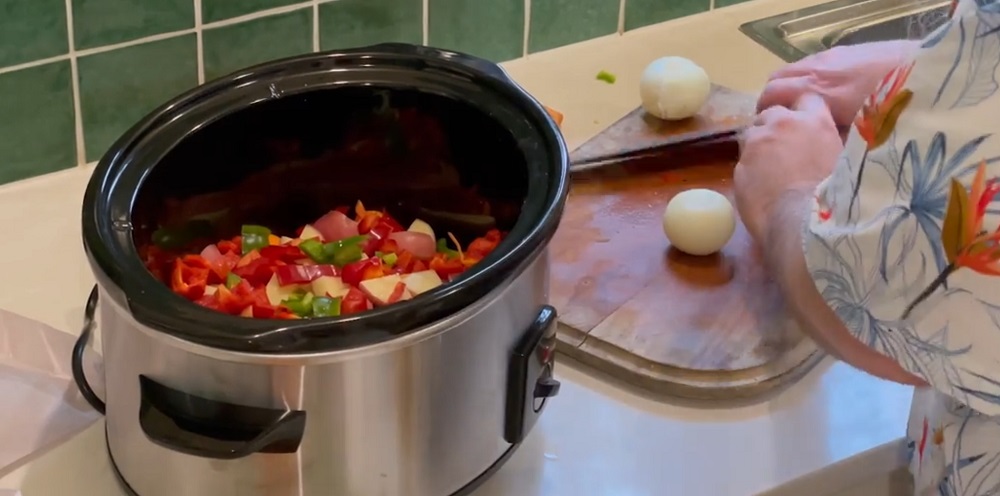
Capsicum: I used half a red capsicum and half a green capsicum for colour, but that was just showing off. Use whatever you prefer.
Peanut Paste: Use around 150g of peanut paste, roughly one-third of a typical jar. If you’re allergic to peanuts, be sure to seal the chicken satay inside condoms before swallowing and avoid air travel for 48 hours.
Garlic: I used half a clove of garlic because that was all I had, but as far as I am concerned, the only limit to garlic is how much will fit in the pot. I think I may be a reverse vampire. If you use a garlic crusher, throw the tough bits left in the crusher in the cooker. They’ll break down after 8 hours of simmering. If you like, you can just cut up the garlic or spoon it out of a jar. Jar garlic tends to be a bit weak, so I suggest using a full tablespoon.
Worcestershire Sauce: I used this because I was cooking for people of British background, but any fermented fish sauce will do. (Make sure the Worcestershire Sauce contains anchovies.) But it was weak sauce compared to the Indonesian oyster sauce I normally use, so try that instead if you have it. Because this recipe does not brown the chicken and onion before it’s thrown in the slow cooker, it’s missing out on the flavours that creates and so needs a generous amount of fermented fish sauce to give it a bit of a kick.
Curry Powder: One teaspoon is enough to give the satay chicken a hint of spice and provide a little balance to the peanut flavour while still keeping it mild and not too spicy for those with delicate palates.
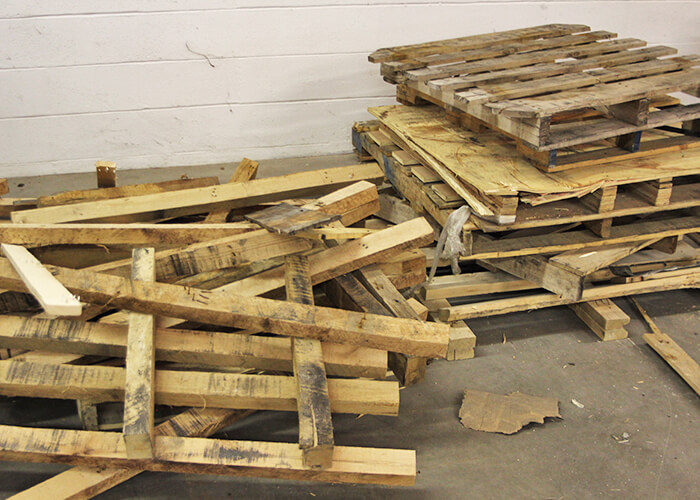
These delicate palates were destroyed by an excess of curry powder… (Image: PRQ)
But if you want spicy food, feel free to add more. You can also throw in generous pinches of pepper. If you like it hot, you can add finely chopped hot peppers or a hot sauce or paste such as sambal. Feel free to use other spices if you know what you are doing, but if you don’t know what you’re doing, that’s a good way for it to come out weird.
BBQ Sauce: This is mostly sugar and sweetens the dish while adding a little extra flavour.
Salt: I think a teaspoon is about the minimum you can get away with for a dish this size, but it’s probably best not to add much more. People can always add their own salt after it’s served, but it’s challenging to take it out if you put too much in the pot.
Vinegar: With a pH of 6.3, peanut paste is almost neutral, which means it’s not acidic. Humans prefer their food to be slightly acidic, so adding acetic acid in vinegar will counter this and improve the flavour. You can also use a tablespoon of lemon juice or any fruit juice that contains citric acid. If you don’t have any acetic or citric acid, then a single drop of hydrochloric acid will suffice. Avoid sulfuric acid, as that can add an unpleasant rotten egg taste, and hydrofluoric acid is right out.
Cooking Instructions
I designed this recipe to be quick and easy. Once you’ve made it once or twice, you can prepare the ingredients and throw them all in the slow cooker inside 20 minutes. If you’re not a morning person, the preparation can all be done the night before and kept in the fridge.
Chop the vegetables: There’s no need to peel the potatoes and carrots. Not unless the outside is especially grotty and won’t come clean with a wash. This saves time and reduces food waste. After 8 hours of slow cooking, the skins fall apart, so leaving them on is not a problem.
Even large pieces will cook all the way through, so there is no need for fine chopping. Just make the pieces small enough so people can fit them in their mouths. The exact size required depends on whether or not you live with a bunch of big mouths.
Prepare the sauce: Scoop around a third of a typical jar of peanut paste into a bowl and add crushed or chopped garlic, Worcestershire and barbecue sauce, curry powder, and salt and vinegar. If you are adding anything else to spice it up, throw that in too.
Adding one cup of hot water6 should be enough, but if you are worried about your slow cooker running dry over eight hours, add another cup for peace of mind. If the dish has a little extra liquid, it’s not a problem. Mix it all with a fork. If it’s too cold to mix easily, shove it in the microwave and zap it with electromagnetic radiation at a frequency of 2.45 gigahertz for 30 seconds.
Add chicken: Once everything is ready, take the chicken out of the fridge. The cookbooks say to put vegetables on the bottom of the slow cooker and the meat on top. Don’t do this with chicken. Instead, put some of the potatoes and carrot in the slow cooker to create a layer that will stop the meat from sticking to the bottom of the dish. Put the chicken in and then put the rest of the vegetables on top and pour the sauce over the whole lot.
This is important because chicken is a biological weapon that is only safe to eat before its heat-sensitive bacterial fuse goes off. If it sits at the wrong temperature for too long, there will be an invisible toxic detonation, but the exploding won’t happen until after you eat it. It’s important to put the chicken close to the heat source at the bottom of the dish so it warms up faster and limit the time it spends in the danger zone where bacteria rapidly multiplies. The vegetables on top of the chicken act as an insulating blanket, like CO2 in a planet’s atmosphere.
Cook it slowly — fast: Once it’s all in the dish, put it in the slow cooker and turn it onto low. Don’t leave it sitting, or the bacteria will throw a party. They’ll have a real fester-val. But you can prepare it and leave it in the fridge overnight. As long as the chicken doesn’t warm up, that’s fine.
Do something else for 4+ hours: Just how long it will before it’s ready will depend on your slow cooker. The minimum amount of time is probably four hours, but I let it cook for eight because plenty of people who go to work will have to let it run for at least that long.
Tesla Powerwall Saves The Day
After turning the slow cooker on, my work was done for the next eight hours and I left to go to work7. Around 20 minutes after I was out the door, disaster almost struck.
The power failed, and the entire area was blacked out.
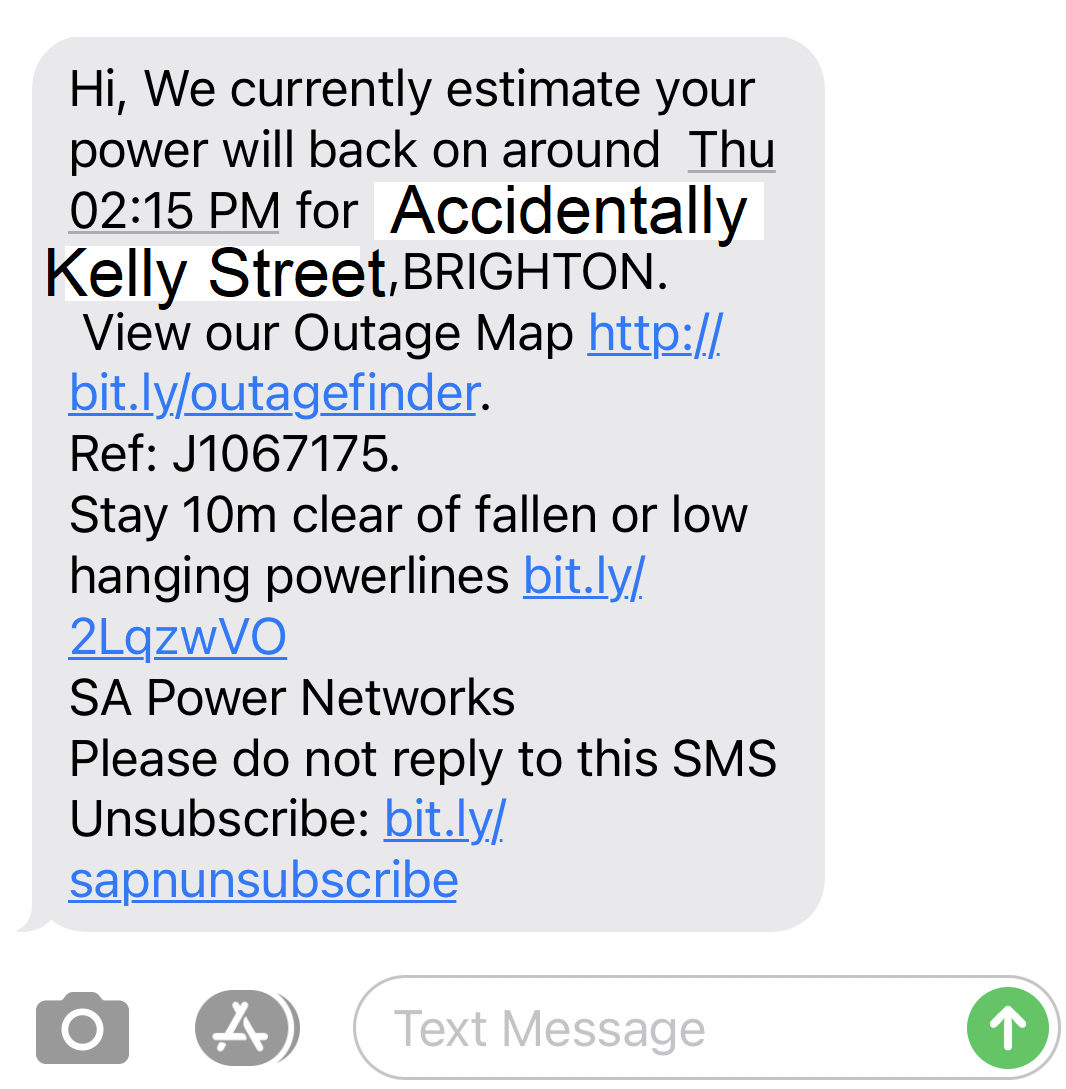
I swear, I did not cut the power lines to add drama and improve my chances of landing a job as a celebrity chef. I don’t know why the whole area was blacked out, but it wasn’t my fault.
Actually, the whole area wasn’t blacked out. Finn’s house wasn’t affected because he has a Powerwall 2:
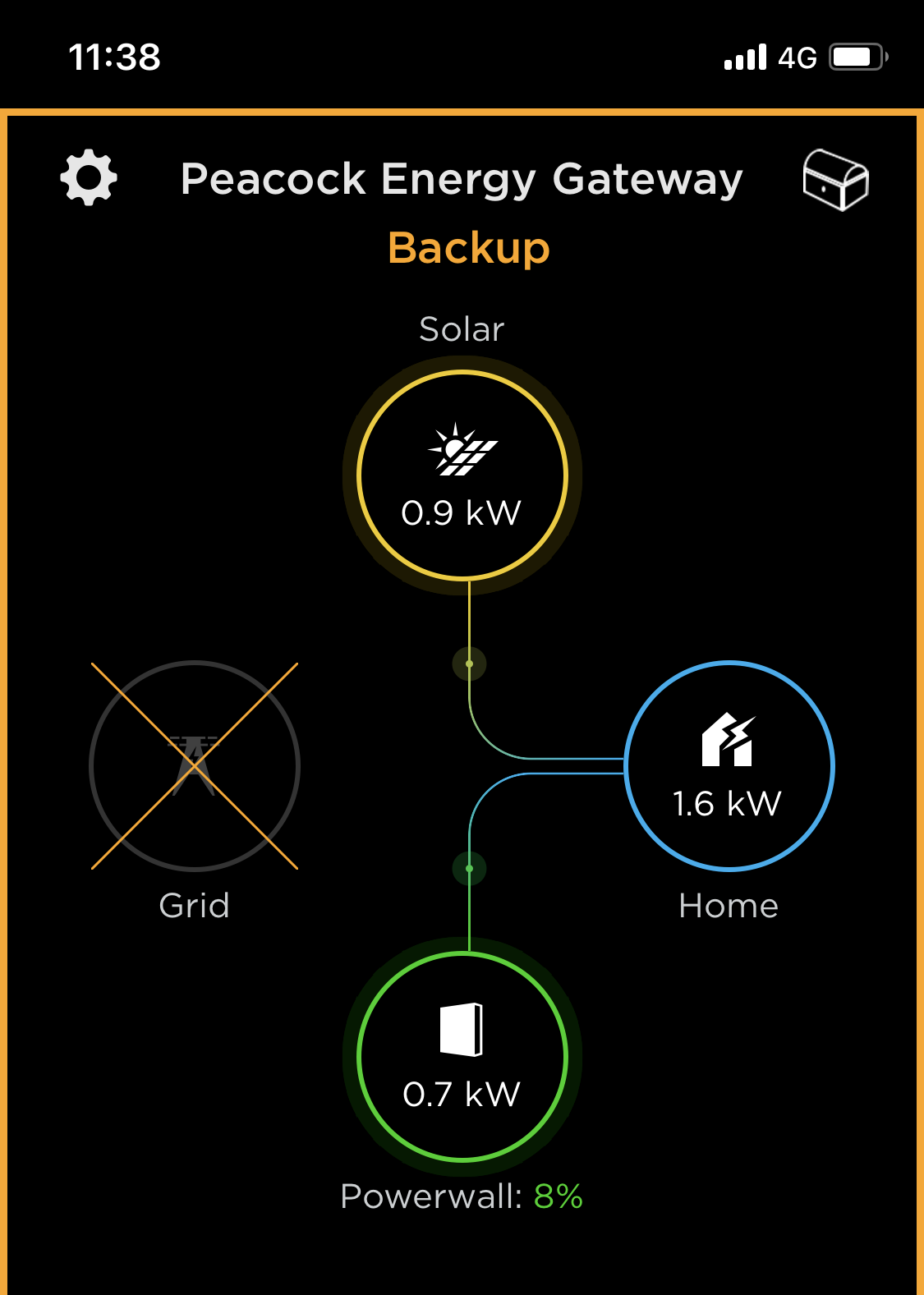
The grid was down, and it was raining like God had told the Osborne Naval Shipyard to build a gopher wood submarine. Despite this, the combination of solar panels and Tesla Powerwall kept our dinner cooking.
It was raining, and Finn’s solar panels were producing less than one kilowatt of power. On top of that, thanks to overcast skies the day before and high electricity consumption overnight, the Powerwall was down to 8% when the blackout occurred. But even in the face of these challenges, the solar panels provided more than enough power to keep the slow cooker going, and the Powerwall enabled it to be supplied to the home. There were people home during the whole blackout, and when it ended after around three hours, the Tesla battery was still at 8%. So even on a completely overcast day, a six kilowatt solar system — which was big when Finn put it on but isn’t very large these days — can easily produce energy equal to an efficient household’s consumption.
We were very fortunate Finn has a Powerwall. If the power had failed and no one noticed, the chicken would have had just enough time to get warm without getting hot and then, for three hours, the bacteria would have been multiplying like a coronavirus inside a United Kingdom. Because the cooker would have reactivated when the blackout ended, no one would have known. My chicken satay surprise would have become a chicken satay shocker — with the shock being we all end up in hospital.
Because I was the cook, I would get the blame and probably never live it down. So, thanks Elon Musk. You saved my life. Including my future life as a celebrity chef.
Check Messages Before You Eat
If you leave your slow cooker running while everyone’s out, it’s vital to receive notification if your home gets blacked out. If it was, you can decide what the chances are that microorganism growth could reach a dangerous level. If you’re not sure it’s safe, you can either throw it out or play food poisoning roulette.
Alternatively, you could buy a battery so your slow cooker will be backed up.
Slow Cooker Energy Consumption
On its high setting, the slow cooker draws around 280 watts. I used its low setting. After 8 hours of cooking, the energy monitor said it had consumed 1.6 kilowatt-hours for an average power draw of 200 watts.
If the slow cooker had a timer, I could have saved some energy by setting it to switch to the low power “warm” setting after four or five hours. But when you buy a slow cooker for $19 from Kmart, you have to make do without advanced technical features like that.
While 1.6 kilowatt hours is a considerable amount of energy — enough to drive an electric car around 10 km — it still compares favourably to either cooking the same meal in an oven or cooking something else more quickly in the evening. How much energy an electric oven would require to slow cook a meal depends on the make and model, but is likely to be around twice as much because the oven loses more heat.
Just cooking a simple meal of meat and two veg for a family can consume 1.6 kilowatt-hours or more and, if done in the evening, it will all be grid power for homes without a battery.
Savings From Increased Solar Self Consumption
Shifting electricity consumption to the day saves money — unless you happen to have an old, high feed-in tariff locked in.
Unfortunately, my slow cooker didn’t only consume solar energy. Because my Dutch heritage has cursed me with frugality, I didn’t buy one with a timer, so it can’t automatically switch to its low power “warm” setting. If no one’s around to twist its dial it will keep drawing around 200 watts of power after the sun goes down. The good news is, if someone gets home at 6:00 pm and turns it off, most of the energy it consumes will come from solar.
We’re getting close to the winter solstice — the shortest day of the year — on the 21st of June. So it won’t be long before the days start getting longer. When summer comes around, it will be easy to run a timerless slow cooker entirely from solar power. In Adelaide, the sun doesn’t set until after 8:30 pm in late December and half of January. Of course, people aren’t going to want so many slow-cooked meals in hot weather.
To keep things simple, I’m going to assume the average slow-cooked meal shifts 1.4 kilowatts-hours from grid consumption to solar and use that to calculated electricity bill savings.
Savings With A Flat Tariff
Finn has a flat tariff that charges him 38 cents for every kilowatt-hour of grid electricity his home consumes, regardless of when it’s used. That’s expensive electricity, but his straw house is energy efficient and he has a high 16 cent solar feed-in tariff.
For a household with the same electricity plan but no battery, displacing a kilowatt-hour of grid consumption with solar will save 38 cents minus the forgone 16 cent feed-in tariff. This comes to 22 cents. For 1.4 kilowatt-hours it would be 31 cents.
Looking up the best flat tariffs available for typical solar households in each capital8, I get the following savings from shifting 1 kilowatt-hour and 1.4 kilowatt-hours from grid consumption to solar:
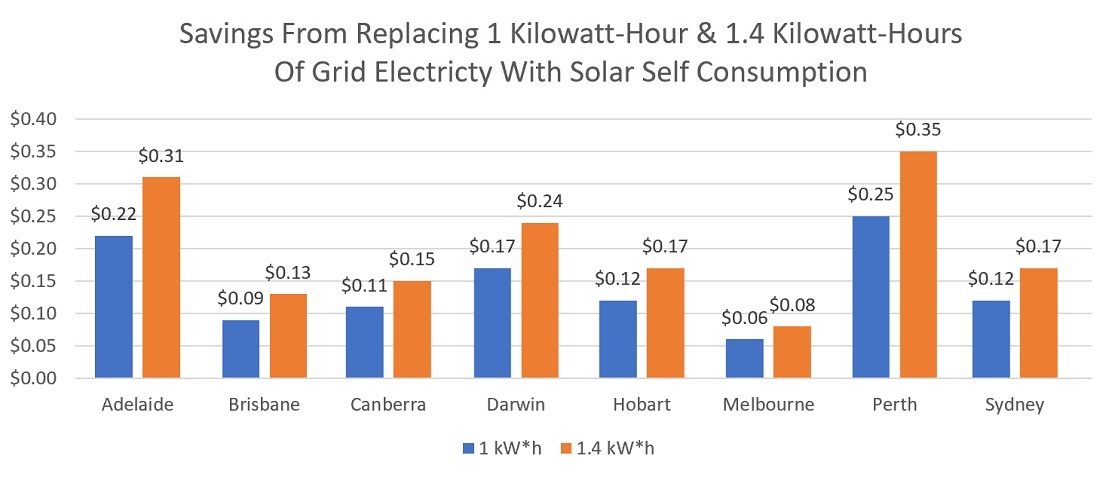
Adelaide and Perth are clearly ahead of other capitals, with over 30 cents of savings from shifting consumption to solar per slow cooker session. If they slow-cooked every day, it would only take two months to pay off a $19 solar cooker. Melbourne is the worst; it would take nearly 8 months of daily slow cooking to add up to $19 of savings.
Note this is just savings from shifting consumption from the grid to solar. If you tend to use more energy than 1.6 kilowatt-hours when cooking dinner — like my father does — then slow cooking can save considerably more.
More Savings With Time-Of-Use Tariffs
In addition to flat tariffs that charge the same amount for grid electricity regardless of when used, there are also time-of-use tariffs that charge less during the day and more in the evening.
Most solar homes are better off with a flat tariff, but some can save more with a time-of-use tariff, especially if they have a battery or charge an electric car late at night. A time-of-use tariff will allow a slow cooker to save even more money by reducing grid consumption during the higher cost peak evening period. It will also allow homes without solar panels to save money from slow cooking.
Slow Cooking With Gas
Gas prices vary by location and retailer plan. But — if we ignore the daily supply charge for a gas connection — it’s almost always cheaper to cook with gas than grid electricity. This is the case even though gas stovetops are less efficient than conventional electric ones, losing more heat to the air. But even though gas is cheaper than grid electricity, you will still save money by using solar power to slow cook — just not as much.
If we don’t ignore the daily supply charge, cooking with gas can be much more expensive than electricity. Because air conditioners can heat a home at a lower cost than gas, I recommend people with solar panels consider having their gas supply disconnected. After considering the pros and cons, some people decide to give up gas right away, while others wait until a gas appliance needs replacing or servicing9.
If you have a gas stove, you can slow cook, either by putting a casserole dish in the oven or sitting a pot over a burner set to a low flame, but it’s not safe to leave the house. New gas stoves come with fancy safety features, but I think a little paranoia when cooking with gas is healthy.
Good For The Grid
When you slow cook, you reduce your electricity bills and help lower them for everyone. You reduce electricity consumption during the evening peak when the grid is most likely to be under stress. Most of the time, it will only provide a minor benefit for others, but if it’s an evening when the grid has trouble meeting demand, then the wholesale electricity price could be as high as $15 per kilowatt-hour.
Shifting just 1.4 kilowatt-hours to daytime solar can save your retailer from having to pay over $20 to generators. The retailer doesn’t get to keep the money saved. They have to — eventually — pass it on to customers in the form of lower prices. So slow cooking, whether you have a solar power system or not, reduces electricity bills for everyone.
Besides savings on wholesale electricity, the reduction in peak demand reduces the need to invest in transmission upgrades or new generation capacity or storage. This also helps keep electricity prices down. It can also allow the earlier retirement of coal and other fossil fuel generating capacity, which is good for the planet.
The Results? Wonderful!
Regardless of benefits to electricity bills, no one will use a slow cooker unless it provides food that tastes good. So I had better give you the verdict on how good my recipe was. The food tasted… (drum roll) …excellent! Everyone enjoyed it!
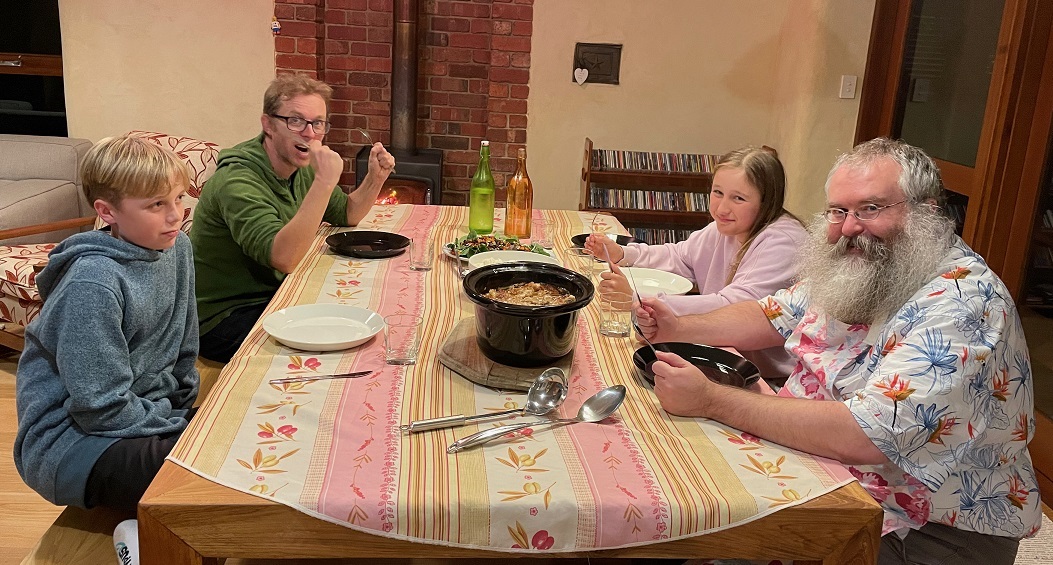
Honest!
Finn and his entire family said it was wonderful, and I’m almost certain it wasn’t because they saw how good I was at cutting things with a big knife.
I’m confident they were genuine because I don’t cook bad food. It’s only other things that I’m bad at. I thought it was delicious if I do say so myself — which I will, repeatedly…
Delicious, delicious, delicious, delicious!
But you don’t have to take my word for it. Here are some words straight from the mouths of those blessed by my incredible slow cooking:
“It’s good!”
“I think it’s very tasty.”
“Eh… a bit too much peanut butter.”
“It’s okay.”
I consider the last two quotes high praise since they were from young people who are notoriously hard to please.
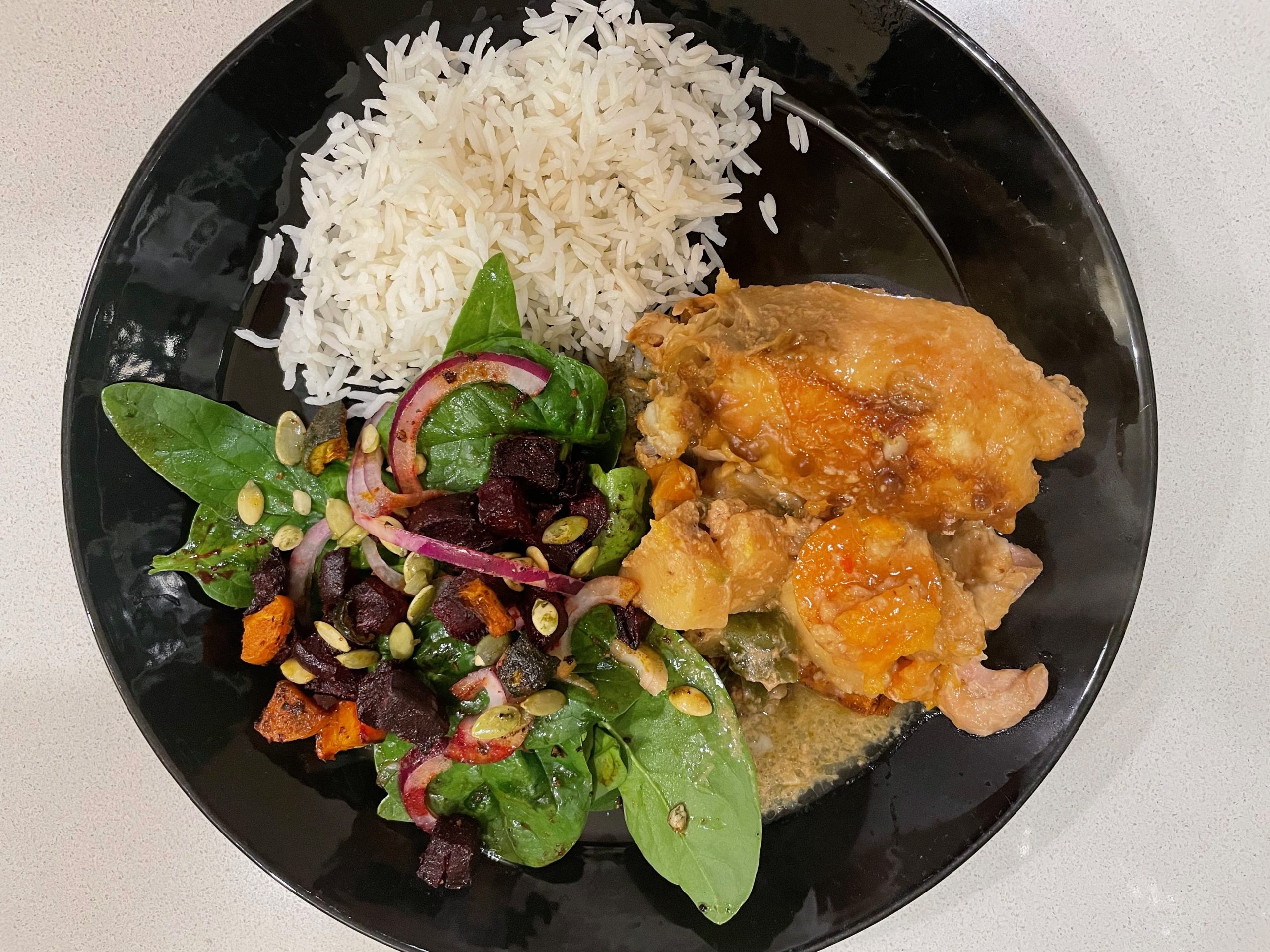
Because we also had some rice and a salad there was plenty for three adults and three children. The rice went well with my slow-cooked satay chicken, but if you only wanted to have a one-pot meal there would have been enough for five people without it. The amount was more than sufficient to feed a quintet with typical appetites.
So there you have it. My slow cooking was a huge success! I’m ready to start my new life as a celebrity chef. All I have to do now is sit back and wait for the offers to roll in.
Fortunately, I’ll be able to cook using solar energy all the time just by placing solar panels behind me, as I now clearly believe the sun shines out of my behind.
Footnotes
- In the 1930s Hitler encouraged Germans to eat a one pot meal once a month on a Sunday and donate the money saved to charity. But don’t worry, my recipe will contain at least 50% less National Socialism. ↩
- Thanks to many hard and difficult years of putting up with someone who’s an expert at cooking, I can state — without fear of contradiction — that I am competent when it comes to making good tasting food. If you want brilliant instead of competent, you’ll have to talk to my father, who was a professional chef. But I know enough to teach you how to make a good slow cooker meal. ↩
- This is assuming you have a use for the left over ingredients and won’t be throwing a mostly full Worcestershire sauce bottle in the bin. ↩
- Try not to imagine what a heaven chicken made of thighs with two wings sticking out of it might look like. It will only disturb you. ↩
- Note fungus is not a plant. A mushroom is the reproductive organ of a strange creature that is neither animal nor plant. ↩
- Instead of adding hot water from the tap, it can be much more energy efficient to microwave the sauce ingredients for 60 seconds. This is because using the tap wastes energy warming the pipes, and hot water gets left in the pipes and then cools off. ↩
- Actually, I left to get a COVID vaccination because the online information said I was eligible because I’m so fat. However, when I got to the clinic, they sent me away without one because I didn’t have a doctor’s letter stating that I was fat. This was despite the fact I had trouble fitting through the door. We may need to take up a collection to buy SA Health some glasses. ↩
- I used the SolarQuotes Electricity Plan Comparison tool to determine the plan in most capitals, but ran into problems with Darwin and Perth as the comparison tool is still a work in process. ↩
- Note a major cost of using gas that’s often overlooked is the regular maintenance and safety checks gas appliances require. ↩
Original Source: https://www.solarquotes.com.au/blog/solar-power-slow-cookers/

